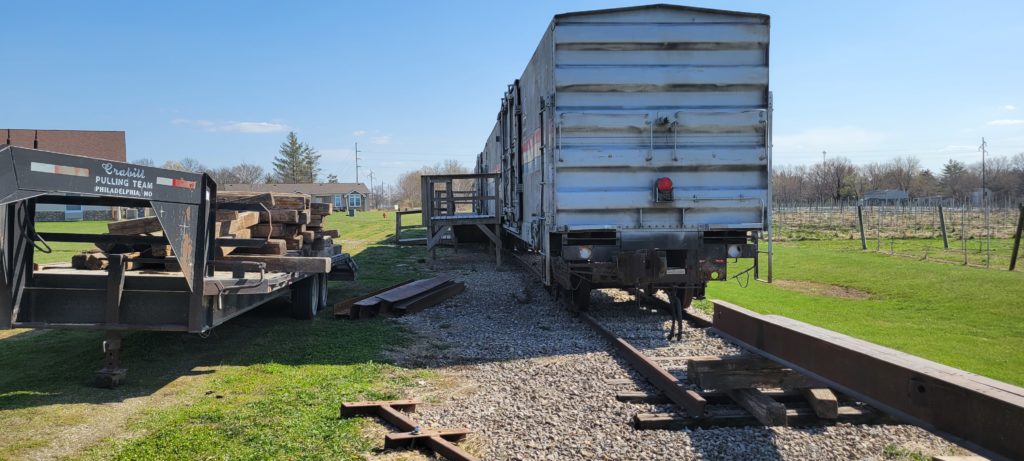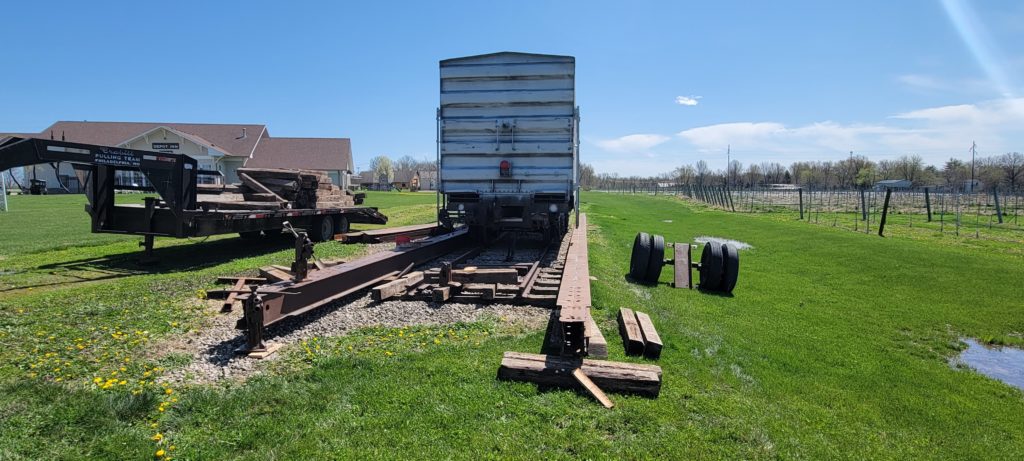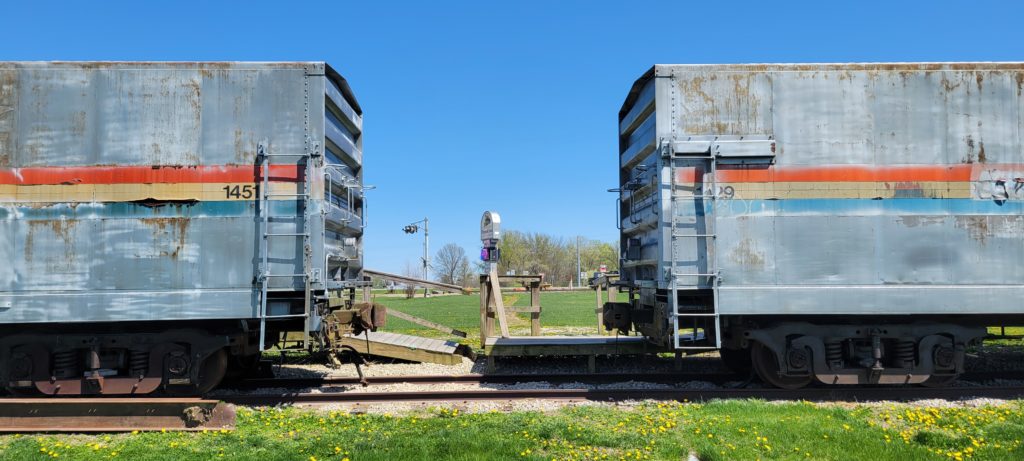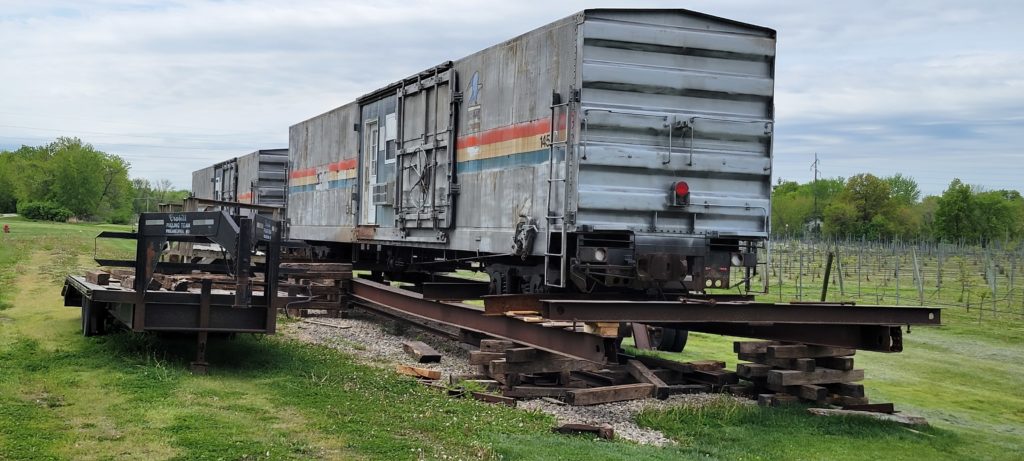This has been a long time coming but good things come to those that wait. We started the fundraiser and planning for these cars to be moved in 2018. Eveyone’s support has allowed us to get the new display track built and the money to move the cars.
Let’s fast forward to late 2020, when the APRHF found an Amish house mover that was willing to move these cars. We found him too late in the year to start in 2020. This year when spring came, so did the movers. The north car that housed the Lionel layout, timetable , 40th anniversary, and uniform display is the first to be readied for movement.
Moses brought all kinds of unique tools, beams, and wood to make this happen. It was really cool to see things change as each day passed. One person and many tools made this 80,000 pound car rise upright off the tracks.
“Patience, careful placement of each beam, and some good measuring is the key,” he said. Moses retired from moving houses a few years ago. Since he liked trains and it was a local job with a relaxed schedule, he decided to do it one last time. For that we are thankful. A local crane company was contacted and could have done it much quicker, but when they said, “find your own semi trucks,” that quickly became an issue that was not possible to fulfill.
Here is a little background on these Ex-Amtrak MHC cars courtesy of UtahRails.net. Ours are the 1400 class.
Material Handling Cars
Amtrak’s Material Handling cars numbered 1400-1479 were the first cars purchased in 1986 for the use of carrying express parcels via Amtrak. The cars were finally taken out of service in 2003. The MHCs were equipped with rebuilt REA trucks built for high speed service (maximum, 110mph) and were custom built for that purpose. When Amtrak removed the MHCs from service they were of no use to any other private railroad.
The Material Handling Cars were built using and new body and rebuilt high-speed trucks from former express cars. The MHC cars had pass-through cabling for HEP and usually operated on the head end of the train. The Southwest Chief usually had four or five daily.
Gene Poon wrote on March 9, 2015:
There were two groups of MHCs.
The 1400-class rode on secondhand trucks originally designed for Railway Express Agency reefers. In the late 1980s a part in those trucks broke and nearly caused a derailment of the Capitol Limited. Since those trucks were long out of production, Amtrak had to get the part redesigned and tested, then get a manufacturer to make it. Until that was done the cars were embargoed by all the freight railroads. Amtrak was not permitted to run them other than on the Northeast Corridor.
Once the redesigned parts were manufactured they were retrofitted to the entire fleet of 1400-class MHCs and the cars returned to service.
The 1500-class MHCs used the same basic truck as operates under Horizon, Superliner II, Viewliner, California and Surfliner cars. By the early 1990s, some of the freight railroads claimed that the trucks, the truck center spacing, and the weight distribution of the cars caused an instability that could cause a tendency to derailment. They embargoed the cars and Amtrak was forced to replace them with baggage cars. Even after the freight railroads had banned the 1500s, Amtrak continued to operate them on Northeast Corridor mail trains without incident.
MHCs were through-wired for HEP and generally maintained and serviced by Amtrak along with the passenger train consists they traveled with.
The 1400-class were built using rebuilt trucks from retired Railway Express Agency express refrigerators cars. These rebuilt express truck assemblies suffered metal fatigue cracking over time. Reportedly there were issues with their trucks “hunting” and jumping the tracks. After a failure of one of the reefer trucks almost caused a derailment of The Capitol Limited, the entire class was embargoed until new parts could be designed, fabricated and installed.
Due to various derailment issues, the Material Handling Cars were held to a maximum speed of 60mph. Because most Amtrak trains operate at much higher speeds (90mph), after the derailment issues came to a head, the MHC’s were set aside.
Of the two series of MHC cars (1400 Class and 1500 Class), the 1500 Class had a permanent red light on each end, with its power coming the 480 HEP. When the permanent rear red light on the 1500s worked properly, it was easier then trying to find a portable red flashing light for the rear end of the train, in case the light on the Rear End Device failed.
The MHCs had been used primarily for handling bulk mail. Most of the mail Amtrak moved was periodicals (magazines and catalogs), still a strong market for the USPS. Amtrak handled less-than-carload (LCL) or less-than-truckload (LTL) palletized periodicals going to one of the more than two dozen bulk mail sorting centers. Printed magazines and catalogs would come out of printing plants in the northeast on several trains, and when the cars arrived at the mail dock in Chicago, the pallets would get repositioned into an MHC going out on Trains 3, 5, 7, or 21. Sometimes there would a full car of mail connecting between trains, but a lot of it was sorted by forklift. The Chicago Union Station sorting was unique and truckers just wanted to handle full truckloads. Mail couldn’t be mixed with other commodities, so that was hard for truckers. Amtrak made good margins on this business, but now that the mail service has ended, the USPS is paying more than it paid Amtrak.
The MHCs had HEP pass-through cabling which allowed them to be on the head end, like baggage cars, and rode on passenger-car-like trucks. Those trucks (on the 1400s) proved to be problematic, though, and when the USPS refused to guarantee the business for a long enough term to justify the cost of new equipment, Amtrak pulled out of handling mail.
Once the MHCs were sidelined, Amtrak sought a USPS commitment for future volume of business sufficient to justify the capital cost of obtaining replacement rolling stock. USPS refused, so Amtrak got out of the bulk-mail business. At about the same time, USPS required its contract carriers to provide “door to door” delivery. Amtrak would have been responsible for getting the mail from the rail station to and from the post office or sorting facility, which are typically no longer located adjacent to downtown train stations.
Now for the photos to do the talking:
There is no set schedule on when this car will move, so there will be no public announcement for that. Rest assured it will be a neat setup when it is moved to its new home. Painting the cars will be next on the list. They will be painted back to original colors and scheme. Donations are still needed for that next step. Here is the GoFundMe fundraiser. We also have a donation area on our website. There is much to be excited for in our future. We invite you to hop on board with us. www.aprhf.org/join
We are so excited to see the next step!! Please stay tuned…




















